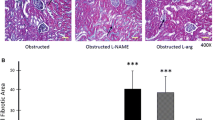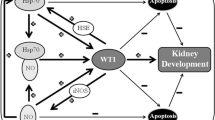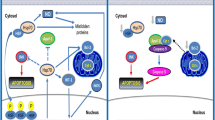Abstract
Perturbation of renal tubular antioxidants and overproduction of reactive oxygen species may amplify the proinflammatory state of renal obstruction, culminating in oxidative stress and tubular loss. Here, we analyzed the heat shock protein 70 (Hsp70) response and the function and signal transduction of NF-E2-related protein 2 (Nrf2) transcription factor on oxidative stress modulation in obstruction. Rats were subjected to unilateral ureteral obstruction or sham operation and kidneys harvested at 5, 7, 10, and 14 days after obstruction. Hsp70 expression and Nrf2 activity and its downstream target gene products were assessed. After 10 and 14 days of obstruction, enhanced lipid peroxidation through higher thiobarbituric acid reactive substances levels and increased oxidative stress resulted in reduced total antioxidant activity and enhanced nicotinamide adenine dinucleotide phosphate reduced (NADPH) oxidase activity were demonstrated. This was accompanied by decreased inducible Hsp70 expression and a progressive reduction of nuclear Nrf2 and its target gene products glutathione S-transferase A2 (GSTA2) and NADPH/quinone oxidoreductase 1 (NQO1), whereas the Nrf2 repressor Kelch-like ECH-associated protein-1 (Keap1) was upregulated. By contrast, on early obstruction for 7 days, lack of increased oxidative markers associated with higher inducible Hsp70 protein levels and a rapid nuclear accumulation of Nrf2, Keap1 downregulation, and mRNA induction of the identified Nrf2-dependent genes, NQO1 and GSTA2, were shown. For these results, we suggest that the magnitude of cytoprotection in early obstruction depends on the combined contribution of induced activation of Nrf2 upregulating its downstream gene products and Hsp70 response. Impaired ability to mount the biological response to the prevailing oxidative stress leading to renal injury was shown in prolonged obstruction.







Similar content being viewed by others
Abbreviations
- ABTS:
-
2,2′-Azinobis-(3-ethylbenzothiazoline-6-sulfonic acid
- AEBSF:
-
4-(2 Aminoethyl)-benzenesulfonyl fluoride
- ARE:
-
Antioxidant response elements
- CAT:
-
Catalase
- CC:
-
Control cortex
- CD:
-
Directive Council
- CEEA:
-
Ethical Committee of Animal Experimentation of Argentina
- CLC:
-
Contralateral cortex
- COX-2:
-
Cyclooxygenase-2
- GPx:
-
Glutathione peroxidase
- GSTA2:
-
Glutathione S-transferase A2
- HDAC1:
-
Histone deacetylase 1
- HO-1:
-
Heme oxygenase-1
- Hsp:
-
Heat shock protein
- IL-1:
-
Interleukin-1
- IL-6:
-
Interleukin-6
- Keap1:
-
Kelch-like ECH-associated protein-1
- L-NAME:
-
L-Arginine methyl ester
- NADPH:
-
Nicotinamide adenine dinucleotide phosphate reduced
- NO:
-
Nitric oxide
- NOS:
-
Nitric oxide synthase
- NQO1:
-
NADPH/quinone oxidoreductase 1
- Nrf2:
-
NF-E2-related nuclear factor erythroid-2
- OC:
-
Obstructive cortex
- ROS:
-
Reactive oxygen species
- SOD:
-
Superoxide dismutase
- TAA:
-
Total antioxidant activity
- TBARS:
-
Thiobarbituric acid reactive substances
- TNF-β:
-
Tumor necrosis factor β
- UUO:
-
Unilateral ureteral obstruction
- 8-OHdG:
-
8-Hydroxy-2′-deoxyguanosine
References
Buege JA, Aust SD (1978) Microsomal lipid peroxidation. Methods Enzymol 52:302–310
Chen ZH, SaitoY YY, Sekine A, Noguchi N, Niki E (2005) 4-Hydroxynonenal induces adaptive response and enhances PC12 cell tolerance primarily through induction of thioredoxin reductase 1 via activation of Nrf2. J Biol Chem 280:41921–41927
Chen H, Wu Y, Zhang Y, Jin L, Luo L, Xue B, Lu C, Zhang YZ (2006) Hsp70 inhibits lipopolysaccharide-induced NF-kappaB activation by interacting with TRAF6 and inhibiting its ubiquitination. FEBS Lett 580:3145–3152
Chevalier RL (1995) Effects of ureteral obstruction on renal growth. Semin Nephrol 15:353–360
Chevalier RL (1999) Molecular and cellular pathophysiology of obstructive nephropathy. Pediatr Nephrol 13:612–619
Chevalier RL, Thornhill BA, Forbes MS, Kiley SC (2010) Mechanisms of renal injury and progression of renal disease in congenital obstructive nephropathy. Pediatr Nephrol 25:687–697
Gulmi F, Felsen D, Vaughan ED Jr (2002) Pathophysiology of urinary tract obstruction. In: Walsh P, Retik A, Vaughan ED Jr, Wein A (eds) Campbell’s urology, 8th edn. Philadelphia, Saunders
Gupta A, Nigam D, Shukla GS, Agarwal AK (1999) Profile of reactive oxygen species generation and antioxidative mechanisms in the maturing rat kidney. J Appl Toxicol 19:55–59
Hahn GM, Li GC (1982) Thermotolerance and heat shock proteins in mammalian cells. Radiat Res 92:452–457
Haugen E, Nath KA (1999) The involvement of oxidative stress in the progression of renal injury. Blood Purif 17(2–3):58–65
Hayes JD, McMahon M (2001) Molecular basis for the contribution of the antioxidant responsive element to cancer chemoprevention. Cancer Lett 174:103–113
Howard MK, Burke LC, Mailhos C, Pizzey A, Gilbert CS, Lawson WD, Collins MK, Thomas NS, Latchman DS (1993) Cell cycle arrest of proliferating neuronal cells by serum deprivation can result in either apoptosis or differentiation. J Neurochem 60:1783–1791
Ishii T, Itoh K, Yamamoto M (2002) Roles of Nrf2 in activation of antioxidant enzyme genes via antioxidant responsive elements. Methods Enzymol 348:182–190
Itoh K, Chiba T, Takahashi S, Ishii T, Igarashi K, Katoh Y, Oyake T, Hayashi N, Satoh K, Hatayama I, Yamamoto M, Nabeshima Y (1997) An Nrf2/small Maf heterodimer mediates the induction of phase II detoxifying enzyme genes through antioxidant response elements. Biochem Biophys Res Commun 236(2):313–322
Itoh K, Wakabayashi N, Katoh Y, Ishii T, Igarashi K, Engel JD, Yamamoto M (1999) Keap1 represses nuclear activation of antioxidant responsive elements by Nrf2 through binding to the amino-terminal Neh2 domain. Genes Dev 13:76–86
Jacobs AT, Marnett LJ (2007) Heat shock factor 1 attenuates 4-hydroxynonenal-mediated apoptosis critical role for heat shock protein 70 induction and stabilization of Bcl-xl. J Biol Chem 282(46):33412–33420
Jaiswal AK (2004) Nrf2 signaling in coordinated activation of antioxidant gene expression. Free Radic Biol Med 36:1199–1207
Jong-Min L, Johnson JA (2004) An important role of Nrf2–ARE pathway in the cellular defense mechanism. J Biochem Mol Biol 37(2):139–143
Kawada N, Moriyama T, Ando A, Fukunaga M, Miyata T, Kurokawa K, Imai E, Hori M (1999) Increased oxidative stress in mouse kidneys with unilateral ureteral obstruction. Kidney Int 56:1004–1013
Kim HJ, Vaziri ND (2010) Contribution of impaired Nrf2–Keap1 pathway to oxidative stress and inflammation in chronic renal failure. Am J Physiol Renal Physiol 298:F662–F671
Kim JH, Yang JI, Jung MH, Hwa JS, Kang KR, Park DJ, Roh GS, Cho GJ, Choi WS, Chang SH (2006) Heme oxygenase-1 protects rat kidney from ureteral obstruction via an antiapoptotic pathway. J Am Soc Nephrol 17:1373–1381
Klahr S, Morrissey J (1998) The role of growth factors, cytokines, and vasoactive compounds in obstructive nephropathy. Semin Nephrol 18:622–632
Klahr S, Morrissey J (2002) Obstructive nephropathy and renal fibrosis. Am J Physiol Renal Physiol 283:F861–F875
Kobayashi M, Yamamoto M (2005) Molecular mechanisms activating the Nrf2–Keap1 pathway of antioxidant gene regulation. Antioxid Redox Signal 7:385–394
Kobayashi M, Yamamoto M (2006) Nrf2–Keap1 regulation of cellular defense mechanisms against electrophiles and reactive oxygen species. Adv Enzyme Regul 46:113–140
Lau SS, Griffin TM, Mestril R (2000) Protection against endotoxemia by HSP70 in rodent cardiomyocytes. Am J Physiol Heart Circ Physiol 278(5):H1439–H1445
Lee JM, Johnson JA (2004) An important role of Nrf2–ARE pathway in the cellular defense mechanism. J Biochem Mol Biol 37(2):139–143
Lee JM, Calkins MJ, Chan K, Kan YW, Johnson JA (2003) Identification of the NF-E2-related factor-2-dependent genes conferring protection against oxidative stress in primary cortical astrocytes using oligonucleotide microarray analysis. J Biol Chem 278:12029–12038
Leonard MO, Kieran NE, Howell K, Burne MJ, Varadarajan R, Dhakshinamoorthy S, Porter AG, O’Farrelly C, Rabb H, Taylor CT (2006) Reoxygenation-specific activation of the antioxidant transcription factor Nrf2 mediates cytoprotective gene expression in ischemia reperfusion injury. FASEB J 20:E2166–E2176
Li Y, Jaiswal AK (1992) Regulation of human NAD(P)H:quinone oxidoreductase gene. Role of AP1 binding site contained within human antioxidant response element. J Biol Chem 267:15097–15104
Li W, Khor TO, Xu C, Shen G, JWS YuS, Kong AN (2008) Activation of Nrf2-antioxidant signaling attenuates NF-κB-inflammatory response and elicits apoptosis. Biochem Pharmacol 76:1485–1489
Manucha W, Vallés PG (2008) Cytoprotective role of nitric oxide associated with Hsp70 expression in neonatal obstructive nephropathy. Nitric Oxide 18(3):204–215
Manucha W, Carrizo L, Ruete C, Molina H, Vallés P (2005) Angiotensin II type I antagonist on oxidative stress and heat shock protein 70 (Hsp70) expression in obstructive nephropathy. Cell Mol Biol (Noisy-le-grand) 51(6):547–557
Matsell DG, Tarantal AF (2002) Experimental models of fetal obstructive nephropathy. Pediatr Nephrol 17:470–476
McMahon M, Itoh K, Yamamoto M, Hayes JD (2003) Keap1-dependent proteasomal degradation of transcription factor Nrf2 contributes to the negative regulation of antioxidant response element-driven gene expression. J Biol Chem 278(24):21592–21600
Pat B, Yang T, Kong C, Watters D, Johnson D, Gobe G (2005) Activation of ERK in renal fibrosis after unilateral ureteral obstruction: modulation by antioxidants. Kidney Int 67:931–943
Re R, Pellegrini N, Proteggente A, Pannala A, Yang M, Rice-Evans C (1999) Antioxidant activity applying an improved ABTS radical cation decolorization assay. Free Radic Biol Med 26(9–10):1231–1237
Ricardo SD, Diamond JR (1998) The role of macrophages and reactive oxygen species in experimental hydronephrosis. Semin Nephrol 18:612–621
Rushmore TH (1990) Transcriptional regulation of the rat glutathione S-transferase Ya subunit gene. Characterization of a xenobiotic-responsive element controlling inducible expression by phenolic antioxidants. J Biol Chem 265:14648–14653
Stewart D, Killeen E, Naquin R, Alam S, Alam J (2003) Degradation of transcription factor Nrf2 via the ubiquitin-proteasome pathway and stabilization by cadmium. J Biol Chem 278(4):2396–2402
Sunami R, Sugiyama H, Wang D, Kobayashi M, Maeshima Y, Yamasaki Y, Masuoka N, Ogawa N, Kira S, Makino H (2004) Acatalasemia sensitizes renal tubular epithelial cells to apoptosis and exacerbates renal fibrosis after unilateral ureteral obstruction. Am J Physiol Renal Physiol 286:F1030–F1038
Van Why S, Hildebrandt F, Ardito T, Mann A, Siegel N, Kashgarian M (1992) Induction and intracellular localization of HSP-72 after renal ischemia. Am J Physiol 263(32):F769–F775
Vaziri ND (2004) Oxidative stress in uremia: nature, mechanisms, and potential consequences. Semin Nephrol 24:469–473
Wakabayashi N, Itoh K, Wakabayashi J, Motohashi H, Noda S, Takahashi S, Imakado S, Kotsuji T, Otsuka F, Roop DR, Harada T, Engel JD, Yamamoto M (2003) Keap1-null mutation leads to postnnatal lethality due to constitutive Nrf2 activation. Nat Genet 35(3):238–245
Warady BA (1997) Renal transplantation, chronic dialysis, and chronic renal insufficiency in children and adolescents. The 1995 annual report of the North American Pediatric Renal Transplant Cooperative Study. Pediatr Nephrol 11:49–64
Yoo KH, Thornhill B, Forbes M, Chevalier RL (2006) Compensatory renal growth due to neonatal ureteral obstruction: implications for clinical studies. Pediatr Nephrol 21:368–375
Acknowledgments
This work was performed with financial from CONICET, PICT/2005N°33827 and from the Research and Technology Council of Cuyo University (CIUNC) Mendoza, Argentina/N: 658/05 to P.G. Vallés.
Author information
Authors and Affiliations
Corresponding author
Rights and permissions
About this article
Cite this article
Rinaldi Tosi, M.E., Bocanegra, V., Manucha, W. et al. The Nrf2–Keap1 cellular defense pathway and heat shock protein 70 (Hsp70) response. Role in protection against oxidative stress in early neonatal unilateral ureteral obstruction (UUO). Cell Stress and Chaperones 16, 57–68 (2011). https://doi.org/10.1007/s12192-010-0221-y
Received:
Revised:
Accepted:
Published:
Issue Date:
DOI: https://doi.org/10.1007/s12192-010-0221-y




